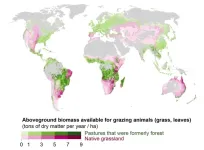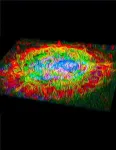Satellite imagery may help protect coastal forests from climate change
2024-11-04
(Press-News.org) Sea-level rise caused by climate change poses a serious and often unpredictable threat to coastal forests, and new tools are needed to help mitigate damage and allocate conservation resources.
A new study from North Carolina State University and the United States Geological Survey (USGS) details how satellite imagery may help identify forested areas that are being transformed into marshes and open water by sea-level rise, a process known as regime change. Marcelo Ardón, associate professor at NC State and co-author of a paper on the study, said that by predicting how an area is changing, this new modeling tool may help conservationists apply their limited funding in areas where it will be the most effective.
“We know that these coastal ecosystems are changing, and it’s hard to predict where and when the change is going to happen. What we found is that through remote sensing, you can get a trajectory of where an area is going,” Ardón said. “That way you can identify which areas might be better to put funding into; if an area might not need help, or if it is just too far into the regime change to pull it back. That in turn can help allocate those limited conservation dollars where they will make the most difference.”
Initially, researchers set out to determine if satellite imagery could be used to detect regime change in coastal wetlands ahead of time by identifying the kinds of early-warning signals that have been found in other ecosystems. These results proved inconsistent, Ardón said. While the data could sometimes detect those signals, it also returned false positives and negatives.
Instead, researchers were able use the same satellite data tool – a metric called the Normalized Difference Vegetation Index – to identify how vegetation health was changing. The NDVI works by using multiple wavelengths from satellite sensors that scan the earth at different times, collecting data on how much red light plants absorb and how much near-infrared light they reflect. Using these values researchers can estimate the NDVI, which effectively measures the greenness and health of plants in the area. The NDVI of a forest is higher than that of a marsh or open water, so it can be used to detect the changes of these systems.
Lead author Melinda Martinez, research ecologist with the USGS, first worked on the study as a Ph.D. student at NC State. She said that the study uncovered stark differences in regime changes between areas that were close together.
“In some areas where regime change was happening quickly, the transitions from forest to marsh or even open water happened within the span of five to six years,” Martinez said. “But then in other areas, sometimes places within the same site, it would happen over much longer periods of time. We knew there would be variation, but we didn’t expect that level of difference between areas in such proximity.”
The study, “Detecting trajectories of regime shifts and loss of resilience in coastal wetlands using remote sensing,” is published in Ecosystems. Authors include Melinda Martinez, Marcelo Ardón and Josh Gray. This work was funded by National Science Foundation (DEB1713502) as well as North Carolina Sea Grant/Space Grant Fellowship.
-pitchford-
Note to Editors: The study abstract follows.
“Detecting trajectories of regime shifts and loss of resilience in coastal wetlands using remote sensing”
Authors: Melinda Martinez, Marcelo Ardon, Josh Gray.
Published: 10/31/2024
DOI: 10.1007/s10021-024-00938-5
Abstract: Many freshwater forested wetlands along the southeastern United States coastline are rapidly transitioning from forest to marsh or open water, due to climate change related disturbances. Recent studies have found early warning signals (EWS) of regime shifts in other ecosystems, but it is unclear if these can be detected for coastal wetlands. In this study, we examined the ability to detect EWS of regime shifts in coastal wetlands within the Albemarle Pamlico peninsula (APP), North Carolina, U.S.A. We used the Landsat record (1985-2021) to examine trends of normalized difference vegetation index (NDVI) time series for selected areas known to have undergone regime shifts. We found that while 77% of the APP was either stable or revegetating, 22% of the landscape underwent a decrease in NDVI that would indicate a transition from forest to marsh or open water. Of the areas that transitioned, about half (11%) experienced an abrupt decrease in NDVI and 10% experienced a gradual decline. Increasing standard deviation and skewness of time series could serve as EWS of abrupt transitions, but can also provide false negative and positives. Our results suggest that ecosystem transitions from a forest to a marsh or open water can occur both rapidly and slowly, and remote sensing of NDVI time series can help identify EWS for some areas, but not all. Our results allow for prioritization of conservation/restoration of coastlines which will become important in the face of climate change and sea level rise.
END
ELSE PRESS RELEASES FROM THIS DATE:
2024-11-04
EMBARGOED UNTIL MONDAY NOVEMBER 4 AT 3:00 P.M. ET
The unique properties of baseball’s famed “magic” mud have never been scientifically quantified — until now.
In a new paper in Proceedings of the National Academy of Sciences (PNAS), researchers at the University of Pennsylvania School of Engineering and Applied Science (Penn Engineering) and School of Arts & Sciences (SAS) reveal what makes the magic mud so special.
“It spreads like a skin cream and grips like sandpaper,” says Shravan Pradeep, the paper’s first author and a postdoctoral researcher in the labs of Douglas J. ...
2024-11-04
Children too young to know words like “impossible” and “improbable” nonetheless understand how possibility works, finds new work with two- and three-year-olds.
The findings, the first to demonstrate that young children distinguish between improbable and impossible events, and learn significantly better after impossible occurrences, is newly published in Proceedings of the National Academy of Sciences.
“Even young toddlers already think about the world in terms of possibilities,” said co-author Lisa Feigenson, co-director of the Johns Hopkins University Laboratory for Child Development. “Adults do this all the time and here we wanted ...
2024-11-04
Scientists and environmental activists have consistently called for drastic reductions in meat production as a way to reduce emissions and, in doing so, combat climate change. However, a new analysis concludes that a smaller reduction, borne by wealthier nations, could remove 125 billion tons of carbon dioxide—exceeding the total number of global fossil fuel emissions over the past three years—from the atmosphere.
Small cutbacks in higher-income countries—approximately 13% of total production—would reduce the amount of land needed for cattle grazing, the researchers note, allowing forests to naturally ...
2024-11-04
**EMBARGOED FOR RELEASE UNTIL NOV. 4 AT 3:00 P.M. EST**
A new study from researchers at Wilmer Eye Institute, Johns Hopkins Medicine explains not only why some patients with wet age-related macular degeneration (or “wet” AMD) fail to have vision improvement with treatment, but also how an experimental drug could be used with existing wet AMD treatments to save vision.
Wet AMD, one of two kinds of AMD, is a progressive eye condition caused by an overgrowth of blood vessels in the retina, the light-sensing tissue in ...
2024-11-04
Between about 120 million and 130 million years ago, during the age of dinosaurs, temperate forests and lakes hosted a lively ecosystem in what is now northeast China. Diverse fossils from that time remained pretty much undisturbed until the 1980s, when villagers started finding exceptionally preserved creatures, which fetched high prices from collectors and museums. This started a fossil gold rush. Both locals and scientists have now dug so much, their work can be seen from space―perhaps the most extensive paleontological excavations anywhere.
By the 1990s, it was clear that the so-called Yixian ...
2024-11-04
If left unchecked, insect pests can devastate crops. To minimize damage and reduce the need for insecticide sprays, crops have been genetically engineered to produce bacterial proteins that kill key pests but are not harmful to people or wildlife. However, widespread planting of such transgenic crops has led to rapid adaptation by some pests. A new study in the Proceedings of the National Academy of Sciences reveals a novel genetic basis of resistance to transgenic crops in one of the most important crop pests in the United States.
Researchers from the University of Arizona Department of Entomology in the College of Agriculture, Life and Environmental Sciences used genomics to investigate the ...
2024-11-04
Jill Tarter to Receive Inaugural Tarter Award for Innovation in the Search for Life Beyond Earth
November 4, 2024, Mountain View, CA – Renowned astronomer, Dr. Jill Tarter, SETI Institute co-founder and pioneering SETI researcher, will be honored with the inaugural Tarter Award for Innovation in the Search for Life Beyond Earth at the SETI Institute’s 40th Anniversary celebration on November 20, 2024, in Menlo Park, CA. This new award recognizes individuals whose projects or ideas significantly advance humanity’s search for extraterrestrial life and intelligence. The Tarter Award honors contributions ...
2024-11-04
November 4, 2024 — The supply of healthcare professionals available to provide HIV care continues to decline, even as the need for HIV care and prevention is expected to increase, reports a survey study in the November/December issue of The Journal of the Association of Nurses in AIDS Care (JANAC). The official journal of the Association of Nurses in AIDS Care, JANAC is published in the Lippincott portfolio by Wolters Kluwer.
"Our study provides new insights into the numbers and characteristics of clinicians who will be available to provide HIV care in the coming years. This information ...
2024-11-04
A team led by researchers at the University of Toronto has uncovered new targets that could be the key to effectively treating glioblastoma, a lethal type of brain cancer. These targets were identified through a screen for genetic vulnerabilities in patient-derived cancer stem cells that represent the variability found in tumours.
Glioblastoma is the most common type of brain cancer in adults. It is also the most challenging to treat due to the resistance of glioblastoma cancer stem cells, from which tumours grow, to therapy. Cancer stem cells that survive after a tumour is treated go on to form new tumours that do not respond to further treatment.
“Glioblastoma tumors have ...
2024-11-04
There is a lung cancer screening test that is saving lives – and yet most people who could be getting the test have never heard of it or never talked about it with a doctor.
“We’ve got a screening test that works. It works as well, if not better, than breast and colorectal cancer screening in terms of mortality reduction. It's one of the most life-saving things we have for a cancer that kills more people than either of those two combined,” said lung cancer pulmonologist Gerard Silvestri, M.D. And yet, he said, “Eighty percent of those eligible for this screening, regardless of race, education, ethnicity, health or income, hadn’t heard of or ...
LAST 30 PRESS RELEASES:
[Press-News.org] Satellite imagery may help protect coastal forests from climate change






